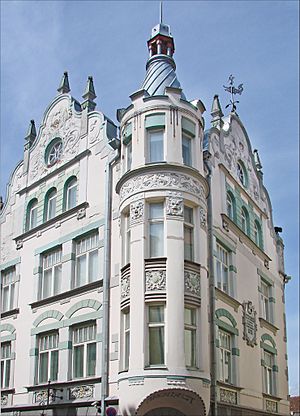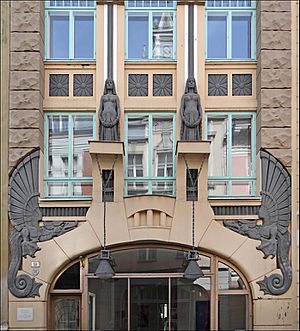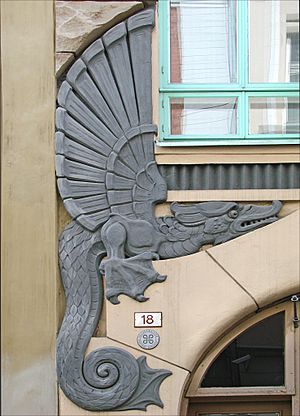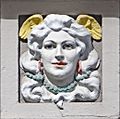Jacques Rosenbaum facts for kids
Jacques Rosenbaum (born 1 July 1878 in Haapsalu, Estonia – died 6 January 1944 in Berlin, Germany) was a famous Estonian architect. He was from a Baltic German family.
Contents
Early Life and Education
Jacques Rosenbaum grew up in Haapsalu and Tallinn. His family was well-known, and his father was a lawyer. His grandfather was also an architect, so building and design ran in the family!
In 1896, Jacques started studying chemistry and architecture. He went to the Riga Polytechnic Institute in Riga. He finished his studies in 1904.
After university, Rosenbaum became the town architect for Tartu. This was a big job! But in 1907, he left Tartu and moved to Tallinn.
Creative Years in Tallinn (1907–1919)
The years from 1907 to 1919 were very busy for Rosenbaum. This was when he designed many of his most creative buildings in Tallinn. His style during this time is mostly called Art Nouveau.
His first ideas were more traditional. They looked like old German buildings. But soon, his unique Art Nouveau style started to show.
The House on Pikk 23/25
In 1908, Rosenbaum finished his first building in Tallinn. It was for Reinhold Reichmann, on the corner of Pikk and Hobuspea streets. This building shows his love for interesting details and decorations.
It mixes different styles like Art Nouveau and older German designs. You can see lots of fancy ornaments. One funny detail is a sculpture of an old man. He is looking across the street through his glasses! This sculpture and others were made by a famous artist named August Volz.
Rosenbaum also thought about how buildings fit into the city. He added a corner tower and balconies to make the street look more lively. People really liked this building, and it helped him become a well-known architect in Tallinn.
The House on Pikk 18
In 1910, Rosenbaum designed another building for Reinhold Reichmann. This one is at Pikk 18, right across the street from his first building. Many people think this is the most famous Art Nouveau building in Tallinn.
It has two huge dragons on the front! These were also made by August Volz. Above them, you can see two serious-looking Egyptian women. They make the building look tall and grand. There are also more Egyptian-style sculptures near the roof. These decorations were meant to have a special meaning, not just to look pretty.
The Bank on Harju 9
Around the same time, Rosenbaum worked on a bank building at Harju 9 in Tallinn. It was finished in 1909. He first planned a very fancy Art Nouveau building. But the final design was a bit simpler and more traditional.
During World War II, this building was badly damaged. When it was fixed, some of the sculpted details were not put back. So, today it looks plainer and more like an old-style stone building.
The House on Roosikrantsi 15
From 1911 to 1912, Rosenbaum designed an apartment building for Gustav Leppenberg. This building is on Roosikrantsi street, number 15. Here, he mixed Art Nouveau with older Baroque styles.
The front of the building is even on both sides, which is not typical for Art Nouveau. It has sculpted lions' heads as decorations. Rosenbaum was likely inspired by other architects from Riga and Vienna.
Laupa Manor
Rosenbaum also designed Laupa manor house in central Estonia. It was built between 1910 and 1913. This grand house also combines Baroque and Rococo styles. It has a balanced design and, like many of his works, a very richly decorated front.
Later Life and Career
In 1919, Rosenbaum moved to Greifswald in Germany with his family. But he came back to Tallinn in 1920. In 1921, he became an Estonian citizen. He even joined an architect firm called Roma.
However, his style of architecture started to go out of fashion. The new Estonian republic wanted different kinds of buildings. One of his last important works in Estonia was the Seamen's Home. It was finished in 1926.
In 1928, Rosenbaum moved back to Germany. During the 1930s and 1940s, he worked for different government agencies. He helped with technical jobs related to building. In 1943, he became an advisor in Riga. He returned to Berlin in 1943 because he was not well. Jacques Rosenbaum passed away on January 6, 1944.
Architectural Style
Most of Jacques Rosenbaum's buildings are known for their Art Nouveau style. But he also used ideas from classicistic and Heimatstil architecture. He was inspired by the Art Nouveau movement in Riga and Finnish national romanticism.
Rosenbaum's buildings often feature amazing sculptures and decorations. Besides homes and villas, he also designed factories and even a fire station in Tallinn. This shows that architects at that time had to be ready for all kinds of projects in a smaller city like Tallinn.
Gallery
-
Süda street 3 in Tallinn, designed with Ernst Gustav Kühnert in 1913.













